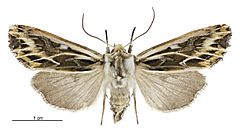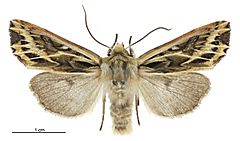Graphania oliveri facts for kids
Quick facts for kids Graphania oliveri |
|
|---|---|
 |
|
| Female | |
 |
|
| Male | |
| Scientific classification | |
| Kingdom: | |
| Phylum: | |
| Class: | |
| Order: | |
| Family: | |
| Genus: | |
| Species: |
G. oliveri
|
| Binomial name | |
| Graphania oliveri (Hampson, 1911)
|
|
| Synonyms | |
|
|
Graphania oliveri is a type of moth that lives only in New Zealand. It belongs to a large group of moths called the Noctuidae family. This moth was first described by a scientist named George Hampson in 1911.
In 2019, another scientist, Robert J. B. Hoare, studied many New Zealand moths. After looking closely at the original samples of this moth, he decided it should be placed in a different group, called the Ichneutica genus. So, its scientific name is now often known as Ichneutica oliveri.
Contents
About the New Zealand Moth
This special moth is an endemic species. This means it is found naturally only in New Zealand and nowhere else in the world. Moths are insects that are related to butterflies. They have wings covered in tiny scales and are usually active at night.
Where Ichneutica oliveri Lives
Since this moth is endemic to New Zealand, you can only find it there. New Zealand has many unique plants and animals because it has been separated from other landmasses for a very long time. The images show areas like the Humboldt Mountains, which are part of the beautiful places where this moth might live.
Its Scientific Name and History
Scientists use special names for every living thing. This helps everyone around the world know exactly which animal or plant they are talking about.
Who Discovered It?
The Graphania oliveri moth was first officially described in 1911 by George Hampson. He was a British scientist who studied moths and butterflies. When a scientist describes a new species, they give it a unique scientific name.
Why Did Its Name Change?
Over time, scientists learn more about different species. In 2019, Robert J. B. Hoare did a big study of many moths in New Zealand. He looked at the original "type specimens" (the first moths used to describe the species). Based on his research, he found that Graphania oliveri was more closely related to moths in the Ichneutica group. This is why its name was updated to Ichneutica oliveri. This kind of change helps scientists keep the classification of living things as accurate as possible.
Images for kids



